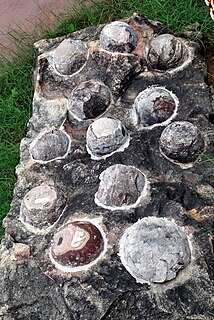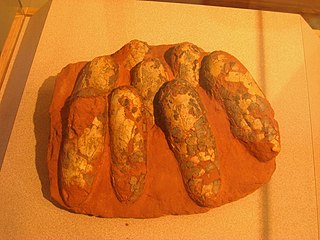Cernaysia is an extinct genus of mammal from the Paleocene of France and the United States. It existed in the age immediately following the extinction of the last dinosaurs. This animal was a member of the extinct order Multituberculata within the suborder Cimolodonta and family Neoplagiaulacidae.

Argiles et Grès à Reptiles Formation, also known as the Argiles Rutilantes Formation is an early Maastrichtian French geologic formation in the département of Var preserving the remains of several types of dinosaurs and other extinct organisms.

Dinosaur eggs are the organic vessels in which a dinosaur embryo develops. When the first scientifically documented remains of non-avian dinosaurs were being described in England during the 1820s, it was presumed that dinosaurs had laid eggs because they were reptiles. In 1859, the first scientifically documented dinosaur egg fossils were discovered in France by Jean-Jacques Poech, although they were mistaken for giant bird eggs.

Cairanoolithus is an oogenus of dinosaur egg which is found in Southwestern Europe. The eggs are large and spherical. Their outer surface is either smooth, or covered with a subdued pattern of ridges interspersed with pits and grooves. Multiple fossil egg clutches are known but the nest structure is unclear.
Sphaerovum is an oogenus of dinosaur egg that has only been discovered in South America.
Shixingoolithus is an oogenus of dinosaur egg from the Cretaceous of Nanxiong, China.

Macroelongatoolithus is an oogenus of large, fossil theropod eggs. They are known from Asia and from North America.

Macroolithus is an oogenus of dinosaur egg belonging to the oofamily Elongatoolithidae. The type oospecies, M. rugustus, was originally described under the now-defunct oogenus name Oolithes. Three other oospecies are known: M. yaotunensis, M. mutabilis, and M. lashuyuanensis. They are relatively large, elongated eggs with a two-layered eggshell. Their nests consist of large, concentric rings of paired eggs. There is evidence of blue-green pigmentation in its shell, which may have helped camouflage the nests.
Subtiliolithus is an oogenus of fossil egg from the Nemegt Formation of Mongolia and the Ohyamashimo Formation of Japan. The eggs are notable for a very thin eggshell. It contains three oospecies: S. hyogoensis, S. kachchhensis and S. microtuberculatus. They were originally classified as a distinct oofamily, Subtiliolithidae, but numerous similarities to Laevisoolithus have led to their reclassification as Laevisoolithid eggs. A complete skeleton of Nanantius valifanovi was found associated with Subtiliolithus eggshells, indicating that the oogenus represents eggs of enantiornithine birds.
Continuoolithus is an oogenus of dinosaur egg found in the late Cretaceous of North America. It is most commonly known from the late Campanian of Alberta and Montana, but specimens have also been found dating to the older Santonian and the younger Maastrichtian. It was laid by an unknown type of theropod. These small eggs are similar to the eggs of oviraptorid dinosaurs, but have a distinctive type of ornamentation.
Ageroolithus is an oogenus of dinosaur egg. It may have been laid by a theropod.
Dispersituberoolithus is an oogenus of fossil egg, which may have been laid by a bird or non-avian theropod.

Egg fossils are the fossilized remains of eggs laid by ancient animals. As evidence of the physiological processes of an animal, egg fossils are considered a type of trace fossil. Under rare circumstances a fossil egg may preserve the remains of the once-developing embryo inside, in which case it also contains body fossils. A wide variety of different animal groups laid eggs that are now preserved in the fossil record beginning in the Paleozoic. Examples include invertebrates like ammonoids as well as vertebrates like fishes, possible amphibians, and reptiles. The latter group includes the many dinosaur eggs that have been recovered from Mesozoic strata. Since the organism responsible for laying any given egg fossil is frequently unknown, scientists classify eggs using a parallel system of taxonomy separate from but modeled after the Linnaean system. This "parataxonomy" is called veterovata.
Laevisoolithidae is an oofamily of fossil eggs belonging to the Ornithoid-ratite morphotype. Their eggshells are smooth and very thin, typically less than a millimeter thick. Laevisoolithids may be the eggs of Enantiornithid birds. Eggs of the family were found in the Grès à Reptiles Formation of France and the Nemegt Formation of Mongolia.
The Rognacian Formation is a geologic formation in France. It is of Maastrichtian age. The mammal Valentinella is known from the formation, alongside indeterminate dinosaur remains.
Pseudomegaloolithus is an oogenus of fossil Megaloolithid egg from Morocco. It is known from eggshell fragments which are distinguished from other Megaloolithid eggs because of its thin shells, fan-shaped eggshell units, and the structure of the nodes and ridges on the eggshell surface. Some egg fragments from India, France, and Peru may actually represent specimens of Pseudomegaloolithus.
Tipoolithus is an oogenus of fossil egg native to the Irbzer Formation in Morocco. Its classification is uncertain, but it most closely resembles Laevisoolithids, and like members of that oofamily, it was laid by an enantiornithine bird or small theropod.

Elongatoolithidae is an oofamily of fossil eggs, representing the eggs of oviraptorosaurs. They are known for their highly elongated shape. Elongatoolithids have been found in Europe, Asia, and both North and South America.
Rodolphoolithus is an oogenus of elongatoolithid egg native to Morocco. It is known only from a single partial egg and several eggshell fragments, but it probably had a highly elongated shape like other Elongatoolithids. They have an eggshell with two layers: a mamillary layer and a continuous layer. The mamillary layer is relatively thick ; it is a half to two thirds the thickness of the continuous layer. The ornamentation of its outer surface is ramotuberculate, i.e. covered with low, irregular ridges. Unfortunately, the pore system cannot be observed due to recrystallization of the fossilized eggshell. Like other Elongatoolithids, Rodolphoolithus was laid by small theropods.
Guegoolithus is an oogenus of fossil egg from the early Cretaceous of Spain. It is classified in the oofamily Spheroolithidae, and was probably laid by an ornithopod dinosaur.





